The deep and sensitive tap root of the Globe Thistle.
I'm absolutely obsessed with this plant. It's beautiful and unusual and the bees adore it. Its been a tricky one to grow, however, last year I only managed to harvest a handful of blooms off some janky looking specimens that didn't look quite right.
I was subsequently offered a lesson by this little guy though when later in the year I decided to transplant one. It was growing awkwardly close to another perennial, so I thought I'd gently relocate it. I dug carefully, or so I thought. But the plant resisted. Quietly. Steadily. Like it knew something I didn't.
What I hadn't realized was just how deep its taproot ran.
When I lifted the plant, I felt that snap - subtle, but final. I knew I hadn't gotten the whole thing. I replanted it anyway. Gave it love. Water. Shade. But the shock had already taken root, and it didn't recover. I realised that these plants, like any with a long deep tap root, had struggled from the beginning when I had transplanted them from seed trays, out into the garden.
The Challenge of Transplanting Deep Things
Echinops is a wild, spiny, striking beauty - it thrives in full sun, poor soil, and dry places where other things struggle.
But its strength is below the surface. It puts everything into a long, central taproot that anchors it deeply.
If you try to move it too late - once it's already settled - it doesn't always survive.
Not because it's weak... but because it committed fully to where it began.
A Mirror of My Own Growth
There was something in that failed transplant that stayed with me.
It reminded me of early trauma - the kind that happens before you can name it. The kind that roots itself in your nervous system. Deep. Quiet. Determined.
Sometimes healing feels like being moved - pulled up and dropped into a new place, even if it's better. But parts of us don't come easily.
We leave roots behind. Or they're torn without us even knowing.
And that rupture... it can make thriving feel harder than it should.
But Still, the Globe Thistle Rises
The original plant didn't recover - the stress turned its leaves yellow and it shot up one single baby, in an effort to produce life ahead of itself. I left it to do its thing and ended up with some viable seeds.
Little silver seedlings popped up around it and rising from the root I thought was broken, another new little plant. Stronger than the parent plant. Ready to give it another go.
That's the thing about Echinops:
Even when disturbed, a single piece of root can regenerate.
It may not be the same shape or timing as before,
but it will come back.
Lessons the Globe Thistle Taught Me
- Growth after trauma is slow and unpredictable.
- Not everything survives the move - and that's okay.
- There's power in putting down roots, even if you're not sure you'll stay.
- And sometimes, from the part that gets left behind, new life happens.
So now, I don't grieve the transplant.
I watch the silver leaves rising from the soil,
and I remember:
Even when something snaps - the story isn't over.
Root Ritual for Gentle Regrowth
I’ve implemented ritual in my life because I needed something deeper than routine — something that could hold me when things fell apart. Ritual gives shape to the unseen. It helps me honour grief, connect with the earth, and slow down enough to feel what’s real. It’s not about perfection — it’s about presence. A way to return to myself, again and again.
This ritual is for times when you've felt uprooted - by grief, by trauma, by transition. It honors the parts of you that couldn't come with you... and the new shoots quietly emerging.
You'll Need:
- A small piece of root or dried herb (echinops root, burdock, or even a stone)
- A candle
- A bowl of soil (or access to a garden)
- A pen and small strip of paper
Steps:
1. Light your candle. Take a few slow breaths. Imagine the flame warming the deepest part of your body - the part that still remembers your earliest stories.
2. Write one thing you feel you lost - a truth, a softness, a part of yourself you didn't get to carry forward.
3. Hold your herb/root or stone and say (softly or aloud):
"Even when the root is cut, the memory remains."
"Even what's been lost can live again in new form."
4. Plant the paper in the soil. As you cover it, whisper:
"I bless what couldn't stay. And I welcome what will grow."
5. Blow out the candle. Place the soil somewhere sacred - on your altar, windowsill, or outside under a plant.
Optional Journal Prompts:
- What part of me feels like it was left behind?
- Where do I see signs of new growth in myself?
- What would it look like to heal without needing to return to "before"?
With earth under my nails, and tenderness in my bones,
Rach x





